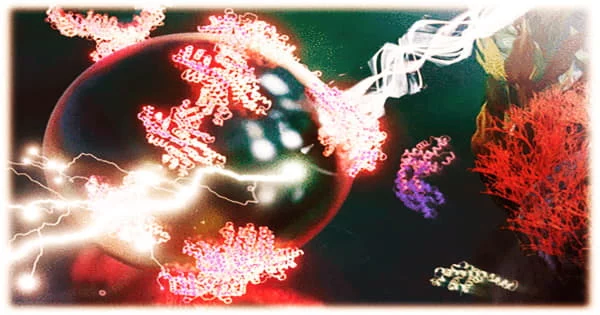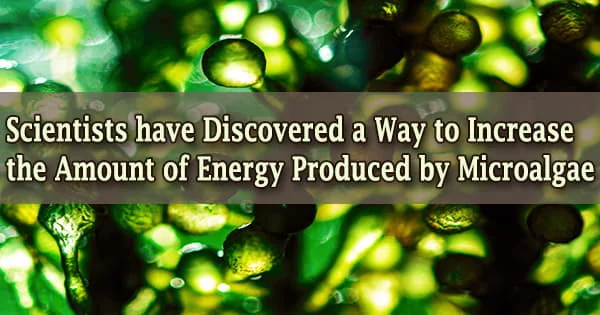The modest algae that blanket the surface of ponds and seas may hold the secret to improving artificial photosynthesis efficiency, allowing scientists to create more energy while reducing waste.
Scientists at Nanyang Technological University in Singapore (NTU Singapore) discovered that encasing algal protein in liquid droplets can boost the algae’s light-harvesting and energy-conversion capabilities by up to three times. Photosynthesis, which is the process by which plants, algae, and some microorganisms harness energy from sunlight and convert it into chemical energy, produces this energy.
Artificial photosynthesis, which mimics how plants turn sunlight into energy, might be a sustainable alternative to non-renewable fossil fuels and natural gas for generating power. Given the poor rate of natural energy conversion from sunlight to electricity, increasing the total amount of electricity generated might make artificial photosynthesis financially feasible.

New bio-inspired technology based on phycobiliproteins might be utilized to make more efficient solar cells, paving the door for higher artificial photosynthesis efficiency.
The research looked at a specific type of protein present in red algae and was headed by Assistant Professor Chen Yu-Cheng from the School of Electrical and Electronic Engineering. These proteins, known as phycobiliproteins, are important for absorbing light and initiating photosynthesis within algal cells.
Phycobiliproteins capture light energy from a wide variety of wavelengths, including those that chlorophylls do not absorb well, and convert it to electricity.
Asst Prof Chen said: “Due to their unique light-emitting and photosynthetic properties, phycobiliproteins have promising potential applications in biotechnology and solid-state devices. Boosting the energy from the light-harvesting apparatus has been at the center of development efforts for organic devices that use light as a power source.”
The team’s study might lead to a new, sustainable method of producing power from the sunshine that does not rely on non-renewable fossil fuels or natural gas. New bio-inspired technology based on phycobiliproteins might be utilized to make more efficient solar cells, paving the door for higher artificial photosynthesis efficiency.
Algae as a source of biological energy is a hot issue in sustainability and renewable energy circles since it has the potential to minimize the quantity of hazardous by-products produced in the production of solar panels.
The research backs up NTU’s commitment to sustainability as part of its 2025 strategic plan, which aims to comprehend, communicate, and remedy humanity’s environmental effect. The findings were published in the scientific journal ACS Applied Materials Interfaces, and the cover was chosen.
Tripling artificial photosynthesis efficiency –
Sunlight is absorbed by microalgae and converted into energy. The study team devised a way to wrap red algae within miniature liquid crystal micro-droplets that are 20 to 40 microns in size and expose them to light in order to increase the amount of energy that algae can create.
When light strikes the droplet, it causes a phenomenon known as “whispering-gallery mode,” in which light waves flow around the droplet’s curving edges. Light is successfully retained within the droplet for a longer length of time, allowing for more photosynthesis to occur and hence more energy generation.
The energy created in the form of free electrons during photosynthesis may subsequently be collected as an electrical current through electrodes.
“The droplet behaves like a resonator that confines a lot of light,” said Asst Prof Chen. “This gives the algae more exposure to light, increasing the rate of photosynthesis. A similar result can be obtained by coating the outside of the droplet with the algae protein too.”
“By exploiting microdroplets as a carrier for light-harvesting biomaterials, the strong local electric field enhancement and photon confinement inside the droplet resulted in significantly higher electricity generation,” he said.
The researchers’ technology is generally applicable since the droplets may be easily generated in mass at a minimal cost.
According to Asst Prof Chen, most algae-based solar cells yield 20-30 microwatts per square centimeter (µW/cm2) of electrical power. When compared to the energy generation rate of the algae protein alone, the NTU algae-droplet combination increased this amount of energy creation by at least two to three times.
Converting “bio-trash” to bio-energy –
The goal of artificial photosynthesis is to mimic the biological mechanism through which plants convert sunlight into chemical energy. The objective is to find a means to make energy that is renewable, dependable, and storable without having a detrimental influence on the environment.
Artificial photosynthesis has a number of obstacles, including generating energy as efficiently as existing sun-powered energy sources, such as solar panels. Solar panels, on average, have a 15 to 20% efficiency rating, although artificial photosynthesis is now predicted to be 4.5 percent efficient.
Asst Prof Chen said: “Artificial photosynthesis is not as efficient as solar cells in generating electricity. However, it is more renewable and sustainable. Due to increasing interest in environmentally-friendly and renewable technologies, extracting energy from light-harvesting proteins in algae has attracted substantial interest in the field of bio-energy.”
Asst Prof Chen sees “algae farms,” in which densely growing algae in bodies of water are eventually merged with bigger liquid crystal droplets to form floating power producers.
“The micro-droplets used in our experiments has the potential to be scaled up to larger droplets which can then be applied to algae outside of a laboratory environment to create energy. While some might consider algae growth to be unsightly, they play a very important role in the environment. Our findings show that there is a way to convert what some might view as ‘bio-trash’ into bio-power,” said Asst Prof Chen.





